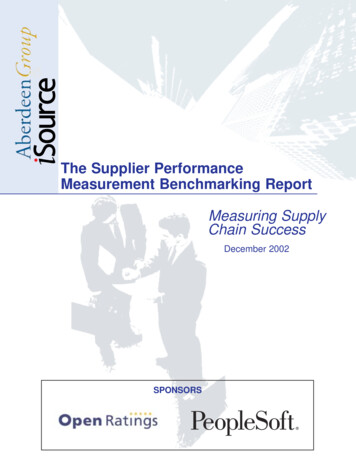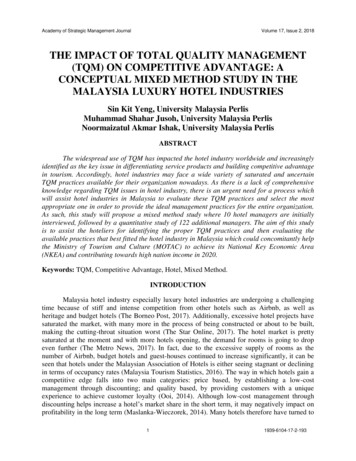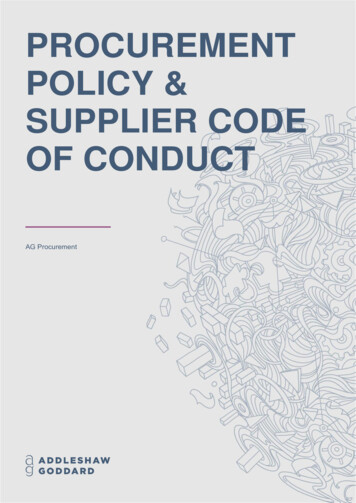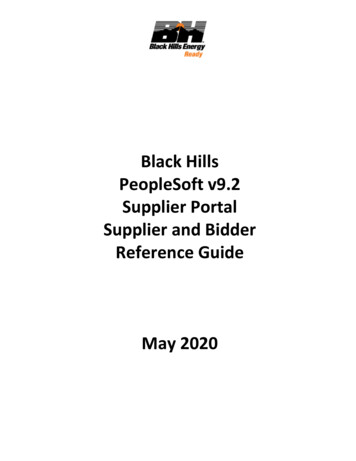
Transcription
&The Supplier PerformanceMeasurement Benchmarking ReportMeasuring SupplyChain SuccessDecember 2002SPONSORS
The Spending Analysis Benchmark ReportTABLEOFCONTENTSExecutive Summary.3Preface .4Methodology .5Supplier Performance Measurement: A Baseline.6Challenges to Effective Performance Measurement .12Performance Measurement “Best Practices” Emerge .13Track the performance of a broader portion of the supply base .14Standardize supplier performance measurement procedures.16Collaborate with suppliers.17Automate key supplier performance measurement activities.18What’s Next in SPM? .19Conclusions.21Author Profiles.22Tim A. Minahan .22Mark W. Vigoroso.22Sponsor Directory .23 2002 AberdeenGroupwww.aberdeen.comwww.isourceonline.com
The Spending Analysis Benchmark ReportExecutive Summary“You can’t improve what you can’t measure.”Dr. Michael Hammer, Re-Engineering the CorporationNowhere does this adage ring truer than in today’s supply chain environments.Global competition, mass customization, heightened customer expectations, andharsh economic conditions are forcing companies to rely on external suppliers tocontribute a larger portion of parts, materials, and assemblies to finished productsand to manage a growing number of processes and functions that were oncecontrolled internally.These trends suggest that future competitiveness will be determined by acompany’s ability to develop strategies to optimally align and manage anextended network of supplier relationships. Put simply, a company’s performanceis increasingly driven by (and reliant upon) the performance of external supplypartners. The effective management of these extended supply networks willrequire companies to employ strategies for measuring and improving theperformance of network participants.Supplier performance measurement is the process of measuring, analyzing, andmanaging supplier performance for the purposes of reducing costs, mitigatingrisk, and driving continuous improvements in value and operations. Commonand consistent measurements can help companies focus resources, identifyperformance glitches, develop strategies for supply chain improvements, anddetermine the total cost of ownership (TCO) of supply relationships, products,and entire supply chains.In November 2002, Aberdeen Group’s supply chain research practice and iSourceBusiness magazine examined the supplier performance measurement practicesof procurement and supply chain executives across multiple industries andgeographies. The findings of this joint Supplier Performance MeasurementBenchmarking Project clearly signal that measuring supplier performance is acritical activity that is sub-optimally managed at most organizations.More than 70% of enterprises examined view measurement of supplier performance as “very important” or “critical” to their companies’ overall operations.However, only about half of enterprises have instituted formal procedures formeasuring supplier performance. Even more alarming, the large majority ofenterprises measure the performance of less than half their supply base. In fact,the typical supplier performance measurement program targets less than a thirdof the total supply base.There is clear evidence that the failure to accurately measure, evaluate, and manage the performance of these partners can increase a company’s costs, damage itsproduct quality, and hinder its competitiveness in the marketplace.Considering the above factors, it is not surprising that nearly 60% of enterprisesare less than satisfied with their ability to consistently measure and managesupplier performance. 2002 AberdeenGroupwww.aberdeen.comwww.isourceonline.com
The Spending Analysis Benchmark ReportThese findings clearly indicate that most organizations continue to grapple withinsufficient and inconsistent supplier performance measurement capabilities.However, the Aberdeen/iSource study also showed clear evidence of the valuethat can be derived from effectively measuring supplier performance. The studyidentified four key strategies that were common to the enterprises achieving thegreatest return from supplier performance measurement:1. Track the performance of a broader portion of the supply base2. Standardize supplier performance measurement procedures across the enterprise3. Collaborate with suppliers on performance metrics, reporting, and improvements4. Automate key supplier performance measurement activities.Specifically, enterprises applying consistent performance measurements and procedures were able to improve supplier performance by more than 26%, on average.This report on the Aberdeen/iSource Supplier Performance MeasurementBenchmarking Project covers the following: Examines the factors driving the increased requirements for measuringsupplier performance; Benchmarks current performance measurement processes on an industry,geographic, and company size basis; Identifies emerging “best practices” for effective supplier performancemeasurement.PrefaceThis is not your father’s business environment. Gone are the days when verticallyintegrated companies can mass-produce products and services that can be marketed for years. With increased competition, mass customization, and continuouspressures to reduce costs and innovate, companies are increasingly relying on anever-expanding network of external partners. Businesses in every industry are fastcoming to the realization that future success will requirethem to organize and manage resources and processesSupplier performance measurement isacross a global network of business partners to rapidlythe process of measuring, analyzing,respond to market changes.and managing supplier performanceSpecifically, about half of every dollar a company earnsfor the purposes of reducing costs,is spent on goods and services provided by externalsuppliers. In certain industries — e.g., high-techmitigating risk, and drivingand automotive — materials, parts, and assembliescontinuous improvement.provided by external suppliers can comprise between70% and 80% of the total cost of new products. In allindustries, companies are outsourcing a wide range of processes and functions— from payroll and accounting to manufacturing, logistics, and procurement— to external suppliers. In fact, by some estimates, U.S. businesses spending onoutsourcing will top 350 billion by next year.To continually manage costs and improve performance, a company must be ablenot only to select the appropriate supply chain partners, but also to monitor andmanage performance of these partners over time. Supplier performance 2002 AberdeenGroupwww.aberdeen.comwww.isourceonline.com
The Spending Analysis Benchmark Reportmeasurement — or what Aberdeen calls “Supplier Performance Management”(SPM) — is the process of measuring, analyzing, and managing supplier performance for the purposes of reducing costs, mitigating risk, and driving continuousimprovements in value and operations.Building on the statistical process control methodologies and principles of totalquality management (TQM), supplier performance measurement applies systematic and statistical process control based on the measurement and management ofstandardized performance metrics. Common and consistent measurements canhelp companies align and focus resources, identify performance glitches anddevelop strategies for addressing these, and determine areas for operationalimprovement across the supply chain.Importantly, supplier performance measurement is vital for determining thetrue total cost of ownership (TCO) of supply relationships, products, and entiresupply chains. The TCO of a supplier relationship includes both the direct costs(e.g., price) and indirect (“hidden”) costs of doing business with a supplier.Examples of hidden costs include the costs of sub-par quality, late deliveries,stock-outs, purchase price variance (PPV) and other non-conformance issues. Ifnot properly measured and managed, such hidden costs can offset and evennegate gains achieved during supplier negotiations.High profile examples of the cost of poor supplier performance abound. In 2000,Ford Motor Company had to recall over 13 million Firestone tires at a cost of 3billion after learning that design and quality glitches were putting certain tiremodels at risk of shedding their treads. That same year, Coca-Cola was forced torecall 15 million cans and bottles of its beverages in key European markets afterseveral consumers became ill. The problem was traced to contaminated chemicalsused at a specific Belgian bottling plant that failed to inspect or monitor thequality of the incoming chemicals used in its products. The incident costCoca-Cola 60 million in lost sales.Both examples demonstrate the impact the upstream supply chain can have on anenterprise’s costs, performance, customer service, and perception in the marketplace. These examples also illustrate the critical importance of effectively measuring and managing supplier performance.MethodologyIn November 2002, Aberdeen Group and iSource Business magazine interviewedprocurement and supply chain executives (e.g., manager-level and above) acrossmultiple industries and geographies on their company’s supplier performancemeasurement procedures. The survey included questions focused on thefollowing areas: The degree to which supplier performance measurement impacts/supportscorporate operations The level to which companies have standardized/formalized supplierperformance measurement procedures 2002 AberdeenGroupwww.aberdeen.comwww.isourceonline.com
The Spending Analysis Benchmark Report How supplier performance information is aggregated, cleansed, sharedand analyzed The use of automation to aid these activities What benefits, if any, have been derived from supplier performancemeasurement initiativesThe responding sample included the following demographics: Industry: Non-manufacturing firms represented 52.6% of survey respondents. Nearly 45% of respondents were from manufacturers. The largestsingle group represented in the sample was from the high-tech sector,followed by automotive manufacturing and pharmaceutical/chemicalmanufacturing, and financial services. Remaining respondents were fromaerospace/defense, construction/engineering, transportation and utilities,retail and distribution, and government and education industries. Title: All respondents were all high-level supply chain executives,including Vice Presidents, Directors, chief officers, and Managers, andof procurement or supply chain operations. Geography: The study included respondents from every major geographicregion. Nearly 65% of respondents were from U.S.-based companies.European Middle East and Africa (EMEA) respondents were a distant second at about 16% of the total sample, followed by Asia-Pacific companies,which represented nearly 12% of respondents. About 8% of respondentswere from companies based in Canada, Latin America, or South America. Size of company: Just over 46% of respondents were from large enterprises(i.e., revenues above 1 billion). Mid-size enterprises (i.e., revenuesbetween 50 million to 1 billion) represented 30.2% of the sample.,Small businesses (i.e., revenues of 50 million or less) represented about18% of the sample.Solution providers recognized as sponsors of this report were solicited afterthe fact and had no influence on the direction of the Supplier PerformanceMeasurement Benchmark Project research effort or the content of this report.Their sponsorship has made it possible for Aberdeen Group and iSource Businessmagazine to make these findings available to readers at no charge.Supplier Performance Measurement: A BaselineConsidering the increased reliance on external supply partners, it is not surprising that more than 70% of responding enterprises view measurement ofsupplier performance as “very important” or “critical” to their operations.Another 17% view supplier performance measurement as “important.” And8% of respondents ranked supplier measurement as “somewhat important.”What is surprising is the lack of consistency in how supplier performance ismeasured within and across enterprises. Just over half (56%) of enterprises 2002 AberdeenGroupwww.aberdeen.comwww.isourceonline.com
The Spending Analysis Benchmark Reportcurrently have formal procedures for measuring supplier performance. Evenmore alarming is the limited scope of most supplier performance measurementprograms. The large majority (72%) of respondents said their company measuresthe performance of less than half its total supply base. In fact, 54% of companiesmeasure the performance of less than a quarter of theirsuppliers. (See chart below.) On average, supplier performance measurement programs address less than a thirdThe typical supplier performance(32.8%) of the total supply base.measurement programs addresses lessthan a third of the total supply base.Most companies have restricted performance measurementprograms based on one or more of three criteria:1. Suppliers that comprise the largest portion of total spending;2. The critical/strategic nature of the product supplied; or3. The critical/strategic nature of the supply relationship. (See chart below.)For example, one transportation company reported that its supplier performancemeasurement program focused only on those suppliers with which it spends atleast 5 million annually. This equates to only 15% of the carrier’s total supplybase.In terms of categories of spending, respondents from manufacturing companiesmost commonly tracked the performance of suppliers providing electronics components and products, IT equipment, office equipment and supplies, customparts, transportation services, MRO goods, and standard parts. Service firmsfocused their performance measurement efforts on suppliers of IT equipment,office equipment and supplies, electronics products and components, customitems, travel, transportation, and professional services. Aberdeen attributes thepreponderance of non-production (“indirect”) and seemingly non-critical categories measured to the breadth of the sample, which included respondents from 2002 AberdeenGroupwww.aberdeen.comwww.isourceonline.com
The Spending Analysis Benchmark Reportmore than 20 major manufacturing, non-manufacturing, and public sectorindustry segments.Certainly, even limited measurement of supplier performance is a step in theright direction. Focusing on critical suppliers or suppliers that constitute thelargest portion of spending enables a company to identify and manage thoseperformance issues that could have the most immediate and greatest impacton its operations and its perception in the market. However, this narrow focusoverlooks lower tier suppliers or suppliers of seemingly non-critical goods andservices that can impact an enterprise’s cost structure, performance, or customerservice.To understand the risks of not tracking the performance and financial viability of the bulk of the supplybase, look no further than the spate of bankruptcyfilings that occurred during the recent economicdownturn. In 2001 alone, 40,099 businesses filedfor bankruptcy — nearly a 12% increase over 2000levels. Through the first three quarters of 2002,nearly 29,000 companies filed for such protection.Such bankruptcies and business closings haveresulted in stock outs, delays, and even outrightproduction shutdowns for many enterprises.By failing to measure the majorityof the supply base, companies areexposing themselves to large-scalequality mishaps, service deficiencies,and cost overruns that can eat intobottom-line profits and damagecompetitive positioning in the market.In short, by failing to measure the majority of the supply base, companies areexposing themselves to large-scale quality mishaps, service deficiencies, and costoverruns that can eat into bottom-line profits and damage competitivepositioning in the market. 2002 AberdeenGroupwww.aberdeen.comwww.isourceonline.com
The Spending Analysis Benchmark ReportThe majority of respondents measure supplier performance in the following areas(See chart below): QualityOn-time deliveryServicePriceTotal costContract complianceLead timesResponsivenessOther areas of supplier performance commonly measured include accuracy ofquotes and promises, technical support, and price variances.Chief uses for supplier performance information include sharing performancemetrics internally across commodity managers, business functions, and divisions;identifying opportunities for improving supplier operations, capacity, or performance; and evaluating suppliers for future business opportunities (see next page). 2002 AberdeenGroupwww.aberdeen.comwww.isourceonline.com
The Spending Analysis Benchmark ReportMany enterprises use measurement information to striate suppliers into performance tiers. For example, if an enterprises uses a rating scale for overall performance of 1 to 100, suppliers receiving a rating of 90 or above would be considered “preferred,” qualifying them for new business opportunities, joint productdevelopment projects, or additional assistance. In addition, enterprises often givenew business proposals (i.e., “bids”) from preferred suppliers additional weight,allowing preferred suppliers to win new business without necessarily being thelowest priced offer.Suppliers scoring between 75 and 90 might be given an “acceptable” rating,making them eligible for new business but requiring them to design a planfor achieving preferred status. Suppliers scoring below 75 will be designated“corrective,” meaning that they will require some form of corrective action toimprove performance deficiencies. Many companies will bar suppliers withcorrective ratings from new business until they attain at least average status.Just over half (54%) of enterprises said they support their supplier performancemeasurement efforts with automation tools. Those with supplier performancemeasurement systems have either built these systems in house (67%) or use theperformance measurement capabilities of their enterprise resource planning(ERP) systems (21%).The majority of responding enterprises (56%) are less than satisfied with theirability to consistently measure supplier performance. Overall, 77% of respondents indicated that there was a need to improve their supplier performancemeasurement capabilities. And nearly 70% of those without formal performancemeasurement programs in place, plan to implement such procedures within thenext year. 2002 AberdeenGroupwww.aberdeen.comwww.isourceonline.com
The Spending Analysis Benchmark ReportChallenges to Effective Performance MeasurementRelated Aberdeen research uncovered three chief factors limiting the scope ofsupplier performance measurement programs:1. Large supplier rolls: Depending on its size and business structure, acompany can deal with hundreds to tens of thousands of suppliers.Tracking the performance of each supplier is a seemingly insurmountable task. However, enterprises that grapple with a supply base that istoo large to measure are ill prepared to effectively manage and mitigaterisk inherent in that supply base.2. Disparate data sources and labor intensive data collection processes:Information on supplier performance is tied up in multiple businesssystems across the enterprise, including enterprise resource planning(ERP), financial, procurement, inventory, logistics, and supply chainexecution systems. The general lack of connectivity between thesesystems (as well as between these systems and other informationsystems within the company) frustrates efforts to aggregate data onsupplier performance. Aggregating data from these disparate sourcesrequires companies to develop integration points into multiple systems.Enterprises are equally challenged to normalize the data aggregatedfrom disparate systems. For example, some business systems might ratesupplier service on a scale from 1 to 10, while another system may usea rating system of 1 to 100. This information must be normalized priorto analysis.3. Inconsistent goals and metrics: It was clear from the Supplier PerformanceBenchmarking Project sample that there continue to be discrepancies inhow companies measure supplier performance between internal 2002 AberdeenGroupwww.aberdeen.comwww.isourceonline.com
The Spending Analysis Benchmark Reportdivisions and sites. Divergences were apparent both in the metrics andthe business systems used to measure supplier performance. Thesefactors have made it difficult for companies to standardize on common metrics and develop a reporting infrastructure that allows thisinformation to be aggregated and normalized for useful analysis andfor rolling up metrics into a supplier scorecard.4. Rudimentary analytical tools: Related Aberdeen research found thatprocurement organizations continue to rely on basic spreadsheetapplications as their primary analysis tools. This practice limits thebreadth and depth of the analyses that can be executed. It also returnsinconsistent results across the company because the sophistication ofanalysis executed varies by the spreadsheet skills of individual buyers.Leading enterprises are utilizing more sophisticated analytical tools —e.g., online analytical processing (OLAP) engines, data warehouses,and modeling engines — for analysis of performance measurementinformation.Performance Measurement “Best Practices” EmergeThe above findings clearly indicate that insufficient and inconsistent supplierperformance measurement capabilities can negatively impact an organization’scost structure and performance and stifle continuous improvement initiatives.However, the Aberdeen/iSource study also showed clear evidence of the valuethat can be derived from effectively measuring supplier performance.Specifically, companies with formal performance measurement programs wereable to improve supplier performance by 26.6%, on average, since the program’sinception. Not surprisingly, the majority of improvements came in the areas of performance mostfrequently measured, including quality, on-timeCompanies with formal performancedelivery, price, total cost, contract compliance, leadmeasurement programs were able totimes, and overall responsiveness. Most of theseimprovements manifested themselves in direct hardimprove supplier performance bydollar savings to the enterprise. The remainder of26.6%, on average.improvements delivered less tangible but equallyimportant enhancements in responsiveness andservice to end customers.The Aberdeen/iSource study identified several practices that were common to theenterprises currently achieving the greatest return from their supplier performance measurement programs:1. Track the performance of a broader portion of the supply base2. Standardize supplier performance measurement procedures across theenterprise3. Collaborate with suppliers on performance metrics, reporting, andimprovements4. Automate key supplier performance measurement activities 2002 AberdeenGroupwww.aberdeen.comwww.isourceonline.com
The Spending Analysis Benchmark ReportTrack the performance of a broader portion of the supply baseEnterprises measuring performance of more than half their total supply base wereable to generate more than double the improvements in supplier performancethan those enterprises that measured less than half their supplier rolls (see chartbelow).Larger enterprises reported tracking performance across a larger portion of theirsupply bases than did small and midsize firms. Aberdeen attributes this broadsupply base coverage to three factors:1. Larger enterprises tend to have more mature and sophisticated supplymanagement strategies than smaller firms;2. Larger enterprises are able to dedicate more resources to supplymanagement issues; and3. Larger enterprises are more likely to have automated key supplymanagement and performance measurement processes than smallerfirms. 2002 AberdeenGroupwww.aberdeen.comwww.isourceonline.com
The Spending Analysis Benchmark ReportAs a group, manufacturers are more aggressive in their supplier performancemeasurement efforts than non-manufacturing firms. Nearly 43% of manufacturers currently apply performance metrics to more than half of their suppliers. Bycomparison, only a third of non-manufacturing firms have performance measurement programs of equal breadth. Aberdeen attributes this dichotomy largelyto the fact that manufacturers tend to have more mature supply managementoperations than non-manufacturing firms, many of which have only recentlybegun to focus on supply chain issues.However, manufacturers have benefited from casting a wide net for supplierperformance measurement. As a group, manufacturers achieved largerimprovements from their supplier performance measurement efforts thannon-manufacturers. 2002 AberdeenGroupwww.aberdeen.comwww.isourceonline.com
The Spending Analysis Benchmark ReportStandardize supplier performance measurement proceduresThe Aberdeen/iSource study cleared showed that enterprises with formalizedperformance measurement programs were able to drive greater improvements insupplier performance (26.6%) than those without such formal procedures (15.8%).On the whole, companies that have standardized supplier performance metricsacross a larger portion of the enterprise were able to achieve better results.Companies that standardized supplier measurements on a business unit or enterprise-wide basis were able to drive at least 25% greater performance improvementsthan those that executed such measurements on a site-by-site basis.However, it was clear from the sample that developing enterprise-wide metricscontinues to be an elusive goal for most organizations. Sixty-one percent ofresponding enterprises with supplier performance measurement programs describedthese initiatives as enterprise-wide in scope. Yet, to date, the companies achievingthe greatest improvements in supplier performance have formalized measurementson a division or business unit basis (see chart below). A likely reason that the business unit approach to supplier performance measurement has returned better resultsis that a single business unit has a common operating style, goals, and requirements,as well as a common supply base to fulfill these requirements. Agreeing on standardmetrics and procedures for measuring supplier performance is an easier task in thisenvironment than on an enterprise basis where different business units have variedrequirements, goals, and suppliers.Aberdeen anticipates that the importance and the challenge of developing standard performance measures will only grow as companies continue to outsourcean increasing portion of their operations. These inter-enterprise alliances willrequire business partners to establish common performance metrics and standardprocedures and systems for measuring cross-enterprise performance. For 2002 AberdeenGroupwww.aberdeen.comwww.isourceonline.com
The Spending Analysis Benchmark Reportexample, OEMs will find it necessary to work with contract manufacturers tojointly define the measures the contractor will use to measure the performanceof sub-tier suppliers.Collaborate with suppliersEnterprises that shared performance data with suppliers were able to generate61% greater improvements in supplier performance than enterprises that onlyused this information internally (see chart below). A chief reason for such gainsis that enterprises sharing performance data with suppliers generally used thisinformation to identify opportunities for improving supplier performance. Manyenterprises have instituted programs to actively solicit improvement suggestionsfrom suppliers and to assist suppliers in implementing such improvements.Some of these enterprises return a portion of the savings generated from suchimprovements back to suppliers. This incentive-based approach to suppliermeasurement encourages continuous improvement, enabling both buyersand suppliers to collaboratively identify areas to extract value from theirrelationships.By contrast, enterprises that kept supplier performance data close to the vestwere more likely to use this information primarily for punitive purposes — e.g.,using performance failures for improved negotiation leverage or to drive supplybase rationalization efforts.Automate key supplier performance measurement activitiesAutomation clearly stood out as one of the key drivers for obtaining value fromsupplier performance measurement. Enterprises that supported their supplierperformance measurement initiatives with automation tools achieved a 57%greater improvement in supplier performance than those without automation(see chart on the next page). 2002 AberdeenGroupwww.aberdeen.comwww.isourceonline.com
The Spending Analysis Benchmark ReportOne example: As a group EMEA respondents were able to achieve the greatestreturn from their supplier performance measurement efforts. Firms from thisregion outpaced the overall sample both in formalizing and automating theirsupplier performance measurement efforts (see chart below). 2002 AberdeenGroupwww.ab
supplier performance measurement is the process of measuring, analyzing, andmanaging supplier performance for the purposes of reducing costs, mitigatingrisk, and driving continuous improvements in value and operations. commonand consistent measurements can help companies focus resources, identifyperformance glitches, develop strategies for supply










